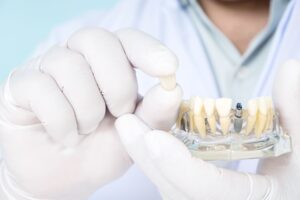Toothy Timeline: The History of Dental Implants

When it comes to replacing teeth, many experts turn to dental implants first because they provide benefits that other techniques don’t. They’re the only restoration that includes a support rod that’s inserted directly into your jawbone. This pole functions like the root of a tooth to keep your jawbone active and healthy. On top of that, these false teeth have an incredibly high success rate of 90%-95% making them an incredibly sought-after solution.
Although today dental implants are reliable and long-lasting, that hasn’t always been the case. Keep reading to learn more about how they evolved over the years and why now is the best time to get them!
Ancient Evidence
Many people are surprised to learn that rudimentary attempts at dental implants have existed for thousands of years. Evidence of early attempts has been found at archeological sites from around the world. For example, in 600 A.D. in China, carved bamboo pegs were fixed on the jaw to serve as replacements. In 1000 B.C., Egyptians carved precious metals and substances like ivory and jade to fill in gaps in their grins. Other cultures used local objects like seashells, stone, or animal teeth and placed them in the sockets left behind by missing pearly whites.
Material Madness
Historically, finding appropriate items to use that can replace teeth was tricky because the human body rejected so many of them. As a result, European scientists began experimenting with new concepts in the years between 1500-1800. They tried making restorations comprised of metallic alloys that included gold, silver, and other materials like porcelain. These false teeth failed consistently, and new solutions were needed.
Modern Makeup
There were no truly successful dental implants until the early 1900s when Drs. Alvin and Moses Strock created fixtures made from Vitallium. They had observed it being used in hip bone surgeries and decided to try adapting it to create dental replacements. Their experiments were successful, and they’re generally recognized as being the first people to insert a replacement tooth into a patient’s jawbone.
Then, in 1952, Dr. Per-Ingvar Branemark was studying bone healing and regeneration. He had placed a piece of titanium into a rabbit’s femur and later realized it couldn’t be removed because the metal had fused with the bone. He decided to try experimenting with titanium in dental implants and finally had success in 1965.
Current Cures
Since that discovery, titanium has continued to be widely used for dental implants. Thanks to continued advancements in dental technology and techniques, they have only gotten better in time. Now they’re considered the pinnacle of restorative methods because they’re so durable and consistent. Plus, they’re capped with dental crowns that can be made of beautiful, lifelike materials so that no one can tell they’re not the teeth you were born with.
Now that you know more about their long and varied history, you can see why now’s the perfect time to consult with your provider about dental implants!
About the Practice
At Fairfax Dental Group, you and the entire family benefit from several experts who provide a full range of services under one roof, including dental implants. They take the time to get to know your unique dental needs and concerns because they know everyone’s situation is different. Then, using advanced technology, they can accurately diagnose any potential problems and provide solutions. Their compassionate staff speak multiple languages so that language barriers don’t keep you and your loved ones from improving your oral health. If you’d like a consultation, you’re welcome to request an appointment on the website or by calling (703) 560-6301.

